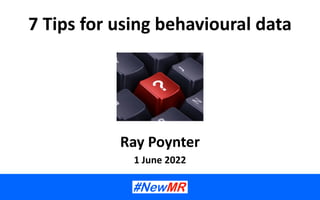
7 tips for using behavioural data - 2022.pdf
- 1. 7 Tips for using behavioural data Ray Poynter 1 June 2022
- 3. Agenda What is behavioural data? 1. What is included? What is missed? 2. Define the granularity 3. What is not Why 4. Causality 5. The lamppost phenomenon 6. Make patterns easier to see 7. Say/Do grids Q & A
- 4. What is behavioural data? Data that describes what people do In its typical form, data that doesn’t depend on people’s memory Examples • Web data (pages viewed, links clicked, search words, ads shown, length of visit etc) • Digital wake (mobile phone usage, ATMs, payments, WiFi connections, messages, emails etc) • Metered data (energy, footfall, traffic flows etc) • Social Media (Facebook, Instagram, Pinterest etc) • Biometrics (smart watches, health apps, Strava etc) • Observations
- 5. 1 What is included? What is missed? Are we including unwanted people? • Do your analytics include people from other countries, non-customers, bots? Who is not included in the data? • PAYG versus contract users • Cash spenders versus cards/digital • Non-loyalty card people versus loyalty card holders • Non-registered users (e.g. people using their own eScooters)
- 6. Where should the armour plating go? By Martin Grandjean (vector), McGeddon (picture), Cameron Moll (concept) - Own work, CC BY-SA 4.0, https://commons.wikimedia.org/w/index.php?curid=102017718
- 7. 2 Define the Granularity Is one data source = one person? Multiple sources -> one person • People with two or more phones or two or more cars • Multiple browsers • Multiple profiles One source -> multiple people • Household data (energy, water, viewing etc) What are the units? • Tampons – packs or individual items
- 8. 3 What is not Why Not buying/choosing/using something does not mean it is not wanted • There could be barriers Doing something regularly does not mean people want to do it • Brands can confuse loyalty with being a hostage Member checking • The gold standard for understanding the why is through ‘talking’ to people • But don’t assume they can/will tell you
- 9. 4 Causality Causality is often difficult to establish from behavioural data ü Weather and switch from bicycles to other transport ✘ HRT and heart problems Experiments • Creating Randomized Control Tests • Natural Experiments
- 10. Missing the Real Driver 0 10 20 30 40 50 60 0 10 20 30 40 50 60 70 80 90 Time 1 Time 2 Time 3 Time 4 Time 5 Time 6 SM $ Sales $ Summer Winter Winter Ice Cream Sales
- 11. Utilising Experiments Region A – T1 sales = 100 – T2, TV, sales = 110 – T3, TV & Twitter, sales = 130 Region B – T1, sales 100 – T2, Twitter, sales = 110 – T3, TV & Twitter, sales = 130 Region C – T1 sales = 100 – T2, sales = 105 – T3, sales = 110 The counterfactual = some growth would have happened anyway.
- 12. 5 The Lamppost Phenomenon Why are you looking for the keys under the lamp, is that where you lost them? No, but this is where the light is!
- 13. 6 Make Patterns Easier to See Fit trendlines or moving averages Transform the data • e.g. per capita, indexing, log scales etc Check for outliers Categorize • e.g. 0 marriages, 1 marriage, 2 or more
- 14. Spending and Child Mortality South Africa Bangladesh USA
- 15. Downloaded from Worldmeters.info 3 March 2021 https://www.worldometers.info/coronavirus/country/uk/
- 16. Downloaded from Worldmeters.info 3 March 2021 https://www.worldometers.info/coronavirus/country/uk/
- 17. Downloaded from Worldmeters.info 3 March 2021 https://www.worldometers.info/coronavirus/country/uk/
- 18. 7 Say / Do Grids Do Say Check if opiate patients need laxatives Prescribe laxatives Buy ethical products Buy Apple products
- 19. 7 Tips 1. What is included? What is missed? 2. Define the granularity 3. What is not Why 4. Causality 5. The lamppost phenomenon 6. Make patterns easier to see 7. Say/Do grids
- 20. Questions?
